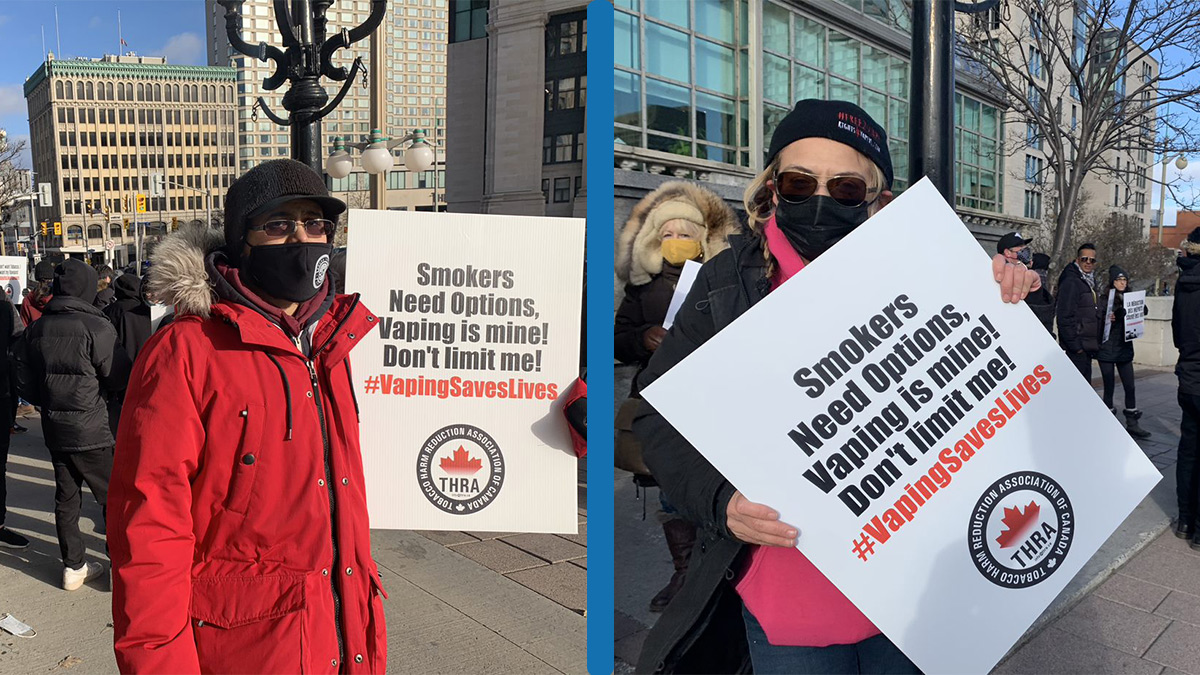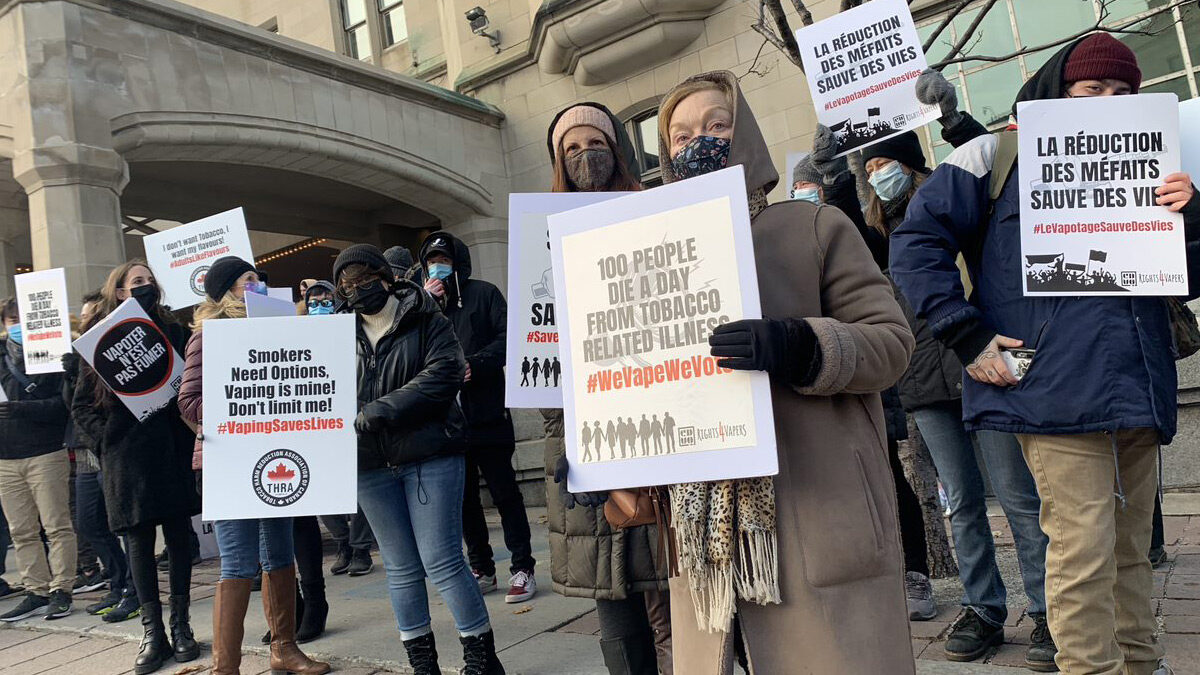The smell of cotton candy and blue raspberry wafted outside the Château Laurier in late November as Canada’s 44th parliament opened its first session nearby — and no, there wasn’t a fair in town to celebrate.

Instead, dozens of vapers — enough to displace sidewalk traffic in front of the grand hotel, directly across from the temporary Senate chambers at 2 Rideau St. — were gathered to express their discontent about Health Canada’s push to ban aromatically sweet varieties of vape pods for consumer purchase.
In June 2021, Health Canada made known its intentions to regulate the sale of flavoured vape products, looking to narrow the variety of fruity and sweet vape options down to plain tobacco and mint/menthol.
The planned regulation was driven by concerns about youth uptake of flavoured products.
The public consultation period lasted 75 days, during which a parliamentary petition against the proposed regulations gained 16,370 signatures, and more than 25,000 feedback submissions were received by Health Canada.

As the public consultation period ended on Sept. 2, the ongoing federal election campaign at the time halted any progress on the potential new rules around vaping. But as the new parliament launched last month and regulations were once again on the table, Rights4Vapers — a consumer group opposed to the planned vape-flavour restrictions — held a rally to protest the Nov. 23 speech from the throne.
“The whole entire goal of Rights4Vapers is to have balanced regulations, where the needs of people who are quitting smoking through vaping products and keeping it out of the hands of minors is looked at equally when it comes to building regulations,” said Maria Papaioannoy, a Rights4Vapers spokesperson. “Currently, smokers are not even part of the discussion when it comes to the current set of regulations and the trajectory that they have taken.”
Moves toward federal regulation come shortly after Nova Scotia provincially banned flavoured vape products in April 2020, with New Brunswick following suit in September 2021. Both provinces say these steps were taken to curb youth interest in the practice.
Despite a new iteration of the Tobacco and Vaping Products Act becoming law in 2018, which prohibits the promotion of nicotine products among other regulations, Health Canada has reported that vaping among youth doubled between 2017 and 2019. Additionally, according to a 2020 survey, 14 per cent of youth aged 15-19 said they had used a vape in the past 30 days, unchanged from 2019.
But Rights4Vapers, including several demonstrators at the Nov. 23 protest, said the focus on preventing youth from using vape products is causing collateral damage among those trying to find a less harmful alternative to smoking.
“When I quit smoking, it was important to get away from smoking; I didn’t want something to remind me of cigarettes,” said Barrington Anglin, a vape user at the rally who found flavoured vapes to be an effective tool in quitting smoking. “My ultimate fear would be that people are either going to be dissuaded from vaping, or a lot of vapers are going to end up going back to smoking, which kind of defeats the purpose.”
Papaioannoy passionately agreed. She advocated for flavoured vapes to be seen as a form of harm reduction that draws smokers away from combustible cigarettes, saying every addict in the country should be respected and not minimized.
“Why are smokers treated differently than any other person that has an addiction? Why do we need to let smokers settle?” Papaioannoy said. “(It’s like saying), ‘Oh, you know what, you’ve already liked the smell of burnt tar, then you need to be able to get the burnt tar smell in a safer way.’”
Health Canada acknowledges some of these concerns but did not offer any clarification on how potential regulations will be augmented to satisfy the concerns of those observing the increase in youth vaping and recovering smokers.
“Health Canada has identified the availability of a variety of flavours as one of the factors that has contributed to the rapid rise in youth vaping, despite existing restrictions on promoting flavours,” Health Canada said in an e-mail statement. “Health Canada is also aware of the role flavours can play in helping people who smoke transition from smoking to vaping products as one alternative source of nicotine that is less harmful than cigarettes if they switch completely to vaping.”
Anglin said he doesn’t believe regulations would even matter to youth who vape, and that as long as youth have a parent, older sibling, or friend who is willing to get nicotine products for them, they will get them — and that a ban on flavours could just send kids back to cigarettes.
“I started smoking at 13. I knew full well that cigarettes taste like garbage. I still did it,” Anglin said. “It just seems like (the government) is punishing the people that have successfully quit smoking and found another viable option, rather than trying to find other measures to limit the access to people in the younger generation.”
Papaioannoy pleaded with youth that may consider vaping, as well as the parents who encourage it, to think about the consequences of their actions beyond just their own bodies, and explained how their choice could take a viable option away from lifelong smokers trying to butt out.
“Youth vapers are a reason for tobacco control to try and take down vaping,” Papaioannoy said. “I started smoking when I was a teen, too. I totally get it. But just know that when I started smoking, they didn’t take away cigarettes from anybody.”





Thank you for shining much-needed light on the proposed flavour ban. To clarify, this flavour ban not only affects “pods”, as stated in this article, it affects all bottled e-liquid used in “open systems” which will decimate the vaping industry.
Worth noting, Health Canada quotes data from 2019 while further data/research is available beyond 2019 to present is never mentioned. The fact is, youth vaping is declining yet no mention of this.
Health Canada is well aware of the consequences of a flavour ban and how this will not only deter future smokers to switch to vaping, it will force adults who have made the switch successfully, to return to smoking, why? With only tobacco, mint and menthol (not mint/menthol…no mixing of the 3 flavours will be permitted) flavours to sell, vape shops will be non-existant as will e-liquid manufactureres who provide these shops with already-regulated e-liquid. No flavours, no age-restricted vape ahops. Period. It’s akin to a produce store selling only broccoli – an impossibly successful business plan.
I’m 63 years old and smoked for 40+ years. I have enjoyed 6 years cigarette free since switching to flavoured vaping products. By making healthier products less accessible to adults who want to quit smoking or remain cigarette free, Health Canada can say good-bye to their goal of 5% smoking rates by 2035 and hello to increased smoking numbers and increased health costs (Nova Scotia has seen increased smoking rates since their flavour ban), all to “protect” youth from an “epidemic” which no longer exists.
It was a fad, think Tide pods.
We shouldn’t have to fight “Health” Canada this hard to save our lives.
This story would have benefitted from additional research, the result of which would have provided better balance.
*The journalist fails to mention that the spokesperson for Rights4Vapers has a commercial interest in the sale of e-cigarettes (she owns a vape shop), and fails to mention the established links between these “consumer” groups and the public relations efforts of large tobacco companies. The journalist should have asked and reported on the funding for Rights4Vapers.
*The journalist fails to contextualize the claims made by these individuals against the available evidence (that flavours lead to youth vaping, that youth vaping leads to tobacco use, that Canadian smokers who turn to e-cigarettes as often as not continue to also smoke cigarettes, that e-cigarettes have not been found to be effective in real world settings, despite some success in clinical trials, etc..
*The journalist’s use of a written message from Health Canada is a tokenistic attempt at balance.
Janine Timmons is mistaken in thinking that Health Canada has more recent data showing a decline in youth vaping. The large survey Health Canada cites (The Canadian Student Tobacco, Alcohol and Drug Survey) was suspended during COVID and the 2019 results cited are the most recent. The smaller survey they fund (The Canadian Tobacco and Nicotine Survey) has not found a statistically significant decline in smoking among youth 15-19 between 2019 and 2020. From this we can estimate that youth vaping rates have not increased. Other surveys may have produced different numbers, but you cannot compare results from different surveys which use different methods.
In response to your points:
*Rights4Vapers is a consumer group, and many of the participants in the Ottawa rally were ex-smokers who rely on vaping and a variety of flavours to stay away from cigarettes. The spokesperson is indeed a vape shop owner, but is also an ex-smoker and one who has helped thousands of smokers to switch to a safer alternative. Vapers are not supporters of the tobacco industry — quite the opposite, as we see ourselves as having escaped from that industry’s products. If the journalist had spoken to any of the other participants, he would have been given exactly the same message, although perhaps with less eloquence.
* I’m not sure what you mean about contextualizing the “available evidence (that flavours lead to youth vaping, that youth vaping leads to tobacco use, that Canadian smokers who turn to e-cigarettes as often as not continue to also smoke cigarettes, that e-cigarettes have not been found to be effective in real world settings, despite ……etc” I’d like to see any evidence, aside from urban legend, that flavours lead to youth vaping, or serves as a gateway to smoking, and all the rest. Many vapers keep abreast of current international research and are aware that the press releases for studies often exaggerate or misinterpret the results. It’s too bad that not enough of our journalists read with the same attention to detail.
* At least Health Canada was honest in stating that flavours are only one of the factors in attracting youth to vaping. In fact, studies earlier this year put peer pressure and curiosity ahead of flavours as reasons for the attraction. The curiosity probably stems from the deluge of press coverage that demonizes vaping and makes it a challenge for young people, so it was refreshing to read an article that has some respect for adult ex-smokers who now vape.
Anyone interested in statistics should have a look at the situation in Nova Scotia, where a flavour ban was imposed over a year ago. Most of the vape shops have closed, and with them the counselling and support that the staff gave to smokers who wanted to switch to a safer alternative. The taxes from vape products fell far short of predictions, and worst of all, Nova Scotia’s smoking rate increased. Yes, the tobacco industry is probably happy with such government support, but the home-grown Canadian small business community has been destroyed.
This comment would have benefitted from additional research, the result of which would have provided better balance.
* The commenter fails to mention that they are the executive director of a lobbying group who thinks vaping is a gateway drug to smoking, and fails to mention the established links between these lobbying groups and big pharmaceutical companies. The commenter should have reported on the funding of their own lobbying group.
* The commenter fails to contextualize their claims as being scientifically inaccurate by promoting the idea that vaping is a gateway drug, confusing the evidence that people likely to vape also present the same risk factors as those likely to smoke, that Canadian smokers who turn to e-cig see double the effectiveness in quitting when vaping than using any big pharma approved cessation method, that e-cig are effectively used in the United Kingdom to combat smoking to the point that their hospitals will even perscribe vapes to patients etc
* the commenters attitude implies the article is heavily biased while ignoring their own bias and doubious scientific claims.
Cynthia Callard: Executive Director, Physicians for a Smoke-Free Canada has her facts wrong. If you are interested do some research. Most of what she says has been debunked. I don’t understand why she would not want to reduce smoking through harm reduction considering her position. Nicotine is about as harmful as caffeine, it is the delivery of nicotine that is the problem. I’m a 61-year old that smoked for 40 years and chose a less harmful product 9 years ago, why would she be against that? What is her motive?